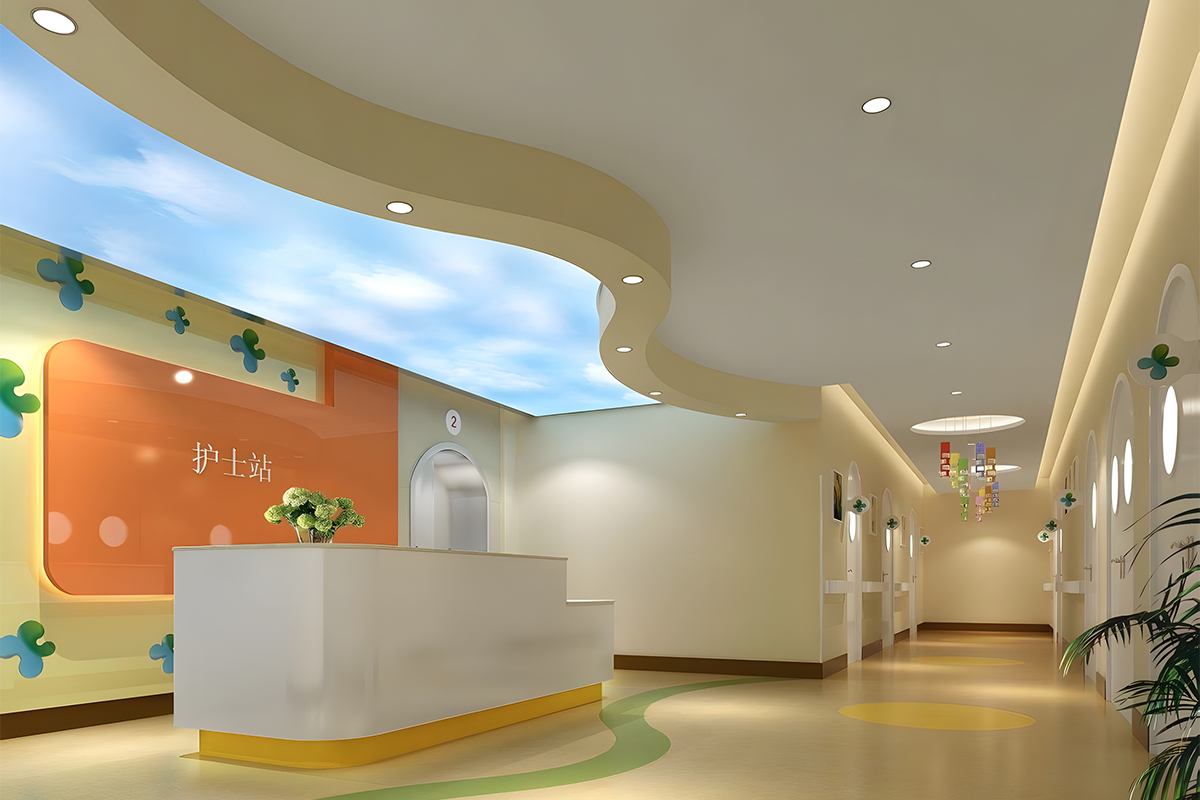Table of Contents Hide
- 1 Hospital lighting
- 2 Task visibility
- 3 Safety
- 4 Comfort
- 5 Photobiological effects
- 6 Psychological impact
- 7 Circadian rhythm regulation
- 8 Patient room lighting
- 9 Examination room lighting
- 10 Operating room lighting
- 11 Diagnostic radiology and imaging room lighting
- 12 LED technology
- 13 Lighting fixtures

Hospital lighting
Hospital lighting is a multifaceted aspect of healthcare facility design that addresses safety, functionality, comfort, and well-being for all occupants. It encompasses a wide range of considerations and elements designed to address the diverse needs of patients, medical staff, caregivers, and visitors within a healthcare environment. General illumination provides overall brightness to ensure visibility and safety in various areas such as corridors, waiting rooms, and public spaces. Task lighting is specifically designed to support specific activities such as reading medical charts, performing procedures, or administering medication. Task lighting ensures sufficient brightness and clarity for precise tasks. Ambient lighting creates a comfortable and welcoming atmosphere, often achieved through soft, diffused lighting in patient rooms and common areas to promote relaxation and reduce stress. Mood lighting is used to create a calming environment, especially in areas where patients may be undergoing treatment or recovering. This can include adjustable lighting to simulate natural daylight cycles or to provide soothing colors. Emergency lighting is essential for maintaining safety during power outages or emergencies, ensuring that critical areas remain adequately illuminated for evacuation and medical procedures. Specialized lighting is tailored to specific healthcare needs such as surgical suites, imaging rooms, and critical care units. These areas often require precise lighting conditions to support medical procedures and diagnostic imaging equipment.Task visibility
Hospital lighting plays a critical role in supporting the diverse visual tasks performed by patients, medical staff, caregivers, and visitors, ultimately contributing to the overall efficiency, safety, and comfort of the healthcare environment. When designing lighting for hospitals, it's crucial to ensure that everyone involved—patients, medical staff, caregivers, and visitors—can effectively carry out various visual tasks with ease, safety, and confidence. This means the lighting should facilitate activities such as reading medical charts, performing procedures, administering medications, navigating corridors and rooms, and providing care for patients. For patients, adequate lighting can contribute to their comfort, well-being, and recovery by helping them feel more at ease and reducing feelings of disorientation or anxiety. It also enables them to engage in activities like reading, eating, or watching television. Medical staff require good lighting to accurately assess and treat patients, read charts and monitors, perform surgeries and procedures, and administer medications. Insufficient lighting can lead to errors, delays, or accidents, jeopardizing patient safety and outcomes. Caregivers, including nurses and aides, rely on proper lighting to assist patients with tasks like bathing, dressing, and mobility. Clear visibility is essential for providing attentive care and responding promptly to patients' needs. Visitors also benefit from well-designed lighting that enhances the overall atmosphere of the hospital, making it more welcoming and comfortable. Adequate lighting in waiting areas and corridors promotes a sense of security and helps visitors navigate the facility with ease.Safety
Healthcare facilities, especially hospitals, cater to a diverse range of individuals with varying needs. Therefore, safety measures must be inclusive and account for different conditions and limitations. For instance, hospital lighting should be designed to accommodate occupants with physical limitations (such as mobility issues), those experiencing emotional distress, and individuals with aging eyesight. Proper lighting can help prevent accidents and improve navigation within the facility for these groups. Prioritizing safety in healthcare facilities, especially hospitals, is essential to provide quality care and protect the well-being of patients, staff, and visitors. Addressing concerns like medication errors and falls requires a comprehensive approach involving infrastructure design, protocols, staff training, and ongoing monitoring and evaluation. Proper lighting can contribute to reducing medication errors by ensuring that healthcare professionals can clearly see medication labels, dosage instructions, and patient information. Inadequate lighting could lead to misreading labels or administering the wrong medication or dosage, which can have serious consequences for patients. Therefore, lighting design in hospitals should prioritize sufficient illumination in medication preparation areas, medication storage spaces, and patient rooms where medications are administered. Adequate lighting is crucial for minimizing the risk of falls among patients, particularly those who may be disoriented, have impaired vision, or are at higher risk due to medical conditions or medications. Well-lit corridors, patient rooms, and common areas can help patients navigate safely and identify potential hazards such as obstacles or changes in elevation. Additionally, proper lighting in bathrooms and near beds can assist patients during nighttime movements, reducing the likelihood of falls.Comfort
Hospital lighting goes beyond just providing illumination; it's designed to create an environment that fosters comfort, calmness, and ultimately, healing. In recent times, there's been a growing recognition of the importance of the overall experience for patients, as well as for the staff and caregivers who support them. By incorporating features that prioritize comfort, hospital lighting aims to create a soothing atmosphere that helps reduce stress and anxiety for patients. Hospitals can employ warm and soft lighting with gentle, diffuse illumination to create a welcoming atmosphere. These types of lighting are less harsh and intrusive, helping to soothe and comfort individuals, especially those who may be feeling anxious or distressed. Soft, diffused lighting can create a more inviting and peaceful environment, which can be particularly beneficial in areas such as patient rooms, waiting areas, and corridors. This approach acknowledges the significant impact that the physical environment can have on patients' emotional well-being and their ability to cope with illness or recovery. Glare and harsh shadows can exacerbate feelings of discomfort and anxiety, particularly for patients who may be sensitive to bright light or have visual impairments. Hospitals can mitigate these effects by using lighting fixtures with diffusers, shields, or indirect lighting techniques to minimize glare and create softer, more uniform illumination. Providing patients with control over their lighting environment, such as adjustable bedside lamps or individual lighting preferences in patient rooms, allows for greater autonomy and comfort. Personalized lighting settings can help patients feel more at ease and empowered during their hospital stay. Moreover, enhancing the experience for staff and caregivers is equally important. Lighting design that considers their needs and preferences can contribute to a more supportive and efficient working environment. Adequate lighting levels, adjustable settings, and ergonomic considerations can help reduce fatigue and improve morale among healthcare professionals, ultimately enhancing the quality of care they provide.Photobiological effects
Hospital lighting must be carefully designed to mitigate these photobiological hazards, ensuring that the illumination provided is safe and conducive to the well-being of patients, staff, and visitors. Ultraviolet (UV) radiation can cause skin damage, such as sunburn and long-term effects like premature aging and an increased risk of skin cancer. It can also lead to eye conditions such as photokeratitis (similar to sunburn of the cornea) and cataracts if exposure is prolonged. Prolonged exposure to intense visible light and infrared (IR) radiation can cause damage to the retina, the light-sensitive tissue at the back of the eye. This damage can lead to conditions like age-related macular degeneration (AMD), which can result in permanent vision loss. Infrared radiation (IR), especially in high intensity, can generate heat that may cause thermal damage to the eyes and skin. This can result in burns or discomfort, particularly if individuals are exposed for extended periods without adequate protection. Poorly designed lighting, such as glare or flickering, can lead to eye strain and fatigue, causing discomfort, headaches, and reduced visual acuity. Eye fatigue can impact the performance of healthcare professionals and may affect patient comfort and recovery. Some individuals may have heightened sensitivity to certain types or intensities of light, leading to discomfort, headaches, or even migraines. Hospital lighting should take into account the needs of such individuals to minimize adverse reactions. Certain patterns or frequencies of light can trigger seizures in individuals with photosensitive epilepsy. Hospital lighting design should avoid using flashing or rapidly changing light patterns that could potentially induce seizures in susceptible patients.Psychological impact
The psychological impact of hospital lighting refers to the influence that lighting design and ambiance within healthcare settings can have on the emotional well-being, mood, and comfort of patients, staff, and visitors. Lighting can influence mood and emotional state. Bright, natural daylighting has been shown to positively impact mood, energy levels, and overall satisfaction among patients and staff. Incorporating elements like daylight simulation or access to outdoor views can help mitigate feelings of confinement and improve morale. Research suggests that exposure to natural light and views of nature can have therapeutic benefits and contribute to the healing process. Hospital lighting design should aim to maximize opportunities for access to natural light, whether through windows, skylights, or light therapy systems, to support patients' recovery and well-being. Incorporating elements of biophilic design, such as views of nature, indoor greenery, or artwork depicting natural scenes, can enhance the healing environment and contribute to reduced stress levels. Hospital lighting can complement these design elements by providing appropriate illumination to highlight and enhance the connection to nature. The psychological impact of lighting extends to healthcare professionals as well. Well-lit workspaces can improve concentration, alertness, and productivity among staff, reducing the risk of errors and improving the quality of care provided to patients. By strategically leveraging lighting design to create welcoming and emotionally supportive environments, hospitals can positively impact the psychological well-being of occupants, fostering a sense of calm, security, and comfort in what can often be stressful and challenging circumstances.Circadian rhythm regulation
Hospital lighting that supports the body's circadian rhythms and reinforces human physiology can contribute to better patient outcomes, improved mood and well-being, and enhanced overall comfort in healthcare settings. Human physiology is influenced by various environmental factors, including light. Hospital lighting design should take into account factors such as the spectral composition of light, brightness levels, and timing of exposure to best support patients' physiological needs. Circadian rhythms are the internal biological clocks that regulate our sleep-wake cycle and other physiological processes over roughly a 24-hour period. Light is one of the most powerful external cues that influence these rhythms. In hospitals, where patients may be confined indoors for extended periods, exposure to natural daylight is often limited. Therefore, artificial lighting plays a crucial role in mimicking the natural changes in light intensity and color temperature throughout the day. Circadian lighting aims to create a more comfortable and healing environment for patients by aligning the lighting environment with the natural rhythms of the human body. Circadian lighting systems are designed to mimic the natural changes in light intensity and color temperature that occur throughout the day, thus helping to regulate patients' circadian rhythms and promote better sleep, mood, and overall health. Circadian lighting systems can adjust the intensity and color temperature of light throughout the day to simulate natural daylight patterns. Bright, cool-toned light is typically provided during the day to promote alertness and productivity, while softer, warmer light is used in the evening to signal the body to wind down and prepare for sleep. Some hospital circadian lighting systems allow for personalized lighting profiles tailored to individual patient needs. This can be particularly beneficial for patients with conditions such as sleep disorders or depression, where specific lighting interventions may be helpful. By providing lighting that aligns with the body's circadian rhythms, hospitals can help patients maintain a regular sleep-wake cycle, which is essential for recovery and overall health.Patient room lighting
Patient room lighting design requires careful consideration of factors such as infection control, patient comfort, safety, and specific medical needs to create environments that promote healing, recovery, and well-being across different healthcare settings. Patient rooms require lighting that allows medical staff to perform tasks such as reading charts, administering medications, and conducting examinations effectively. Adequate task lighting, such as adjustable bedside lamps or overhead fixtures with focused illumination, is essential to ensure accurate diagnosis and treatment. Lighting in patient rooms should create a comfortable and welcoming environment for patients, contributing to their overall well-being and recovery. Soft, diffused lighting can help reduce glare and create a calming atmosphere conducive to rest and relaxation. Patient room lighting systems should offer flexibility and control options to accommodate different patient preferences, medical needs, and activities. Dimmable lighting controls, bedside lighting controls, and programmable lighting scenes can allow patients to adjust the lighting to their liking and promote a sense of autonomy and comfort. Patient room lighting should prioritize safety and accessibility, with consideration for patients with mobility impairments, visual impairments, or other special needs. Illuminated pathway lighting, accessible controls, and emergency lighting systems are essential to ensure patient safety and ease of movement within the room. Infection control is a critical consideration in patient rooms, particularly in settings such as isolation rooms or areas where patients may be immunocompromised. Lighting fixtures should be easy to clean and maintain to minimize the risk of pathogen transmission. Sealed, antimicrobial, or disposable lighting options may be utilized to enhance infection control measures.Lighting in AIIR (Airborne Infection Isolation Room) and PE (Protective Environment) rooms should meet specific infection control requirements and minimize the risk of cross-contamination. Sealed, easy-to-clean fixtures with smooth surfaces are preferred to prevent the accumulation of dust and pathogens. Indirect lighting and fixtures with antimicrobial properties may be used to enhance cleanliness. Lighting in critical care units should balance the need for visibility with patient comfort and rest. Dimmable lighting systems allow for adjustment based on patient condition and time of day. Special attention should be given to glare control to minimize disruption to patients undergoing sensitive procedures or treatments. Lighting in obstetrical units should support a calm and soothing atmosphere for expectant mothers during labor and delivery. Adjustable lighting levels and color temperature can help create a relaxing environment. Lighting in nursery units and NICUs should be carefully designed to promote infant well-being and development. Indirect, low-level lighting is preferred to minimize stress and discomfort for newborns. Lighting should meet specific guidelines to protect premature infants' sensitive eyes and promote healthy sleep patterns. Lighting in pediatric units should be child-friendly and engaging while still meeting functional requirements. Colorful, decorative lighting fixtures and interactive elements can help create a positive and comforting environment for pediatric patients. Lighting should be adjustable to accommodate different activities and age groups. Lighting in psychiatric units should balance safety and security with patient comfort and well-being. Fixtures should be tamper-resistant and shatterproof to minimize potential hazards. Soft, diffuse lighting can help create a calming atmosphere and reduce agitation among patients.











































